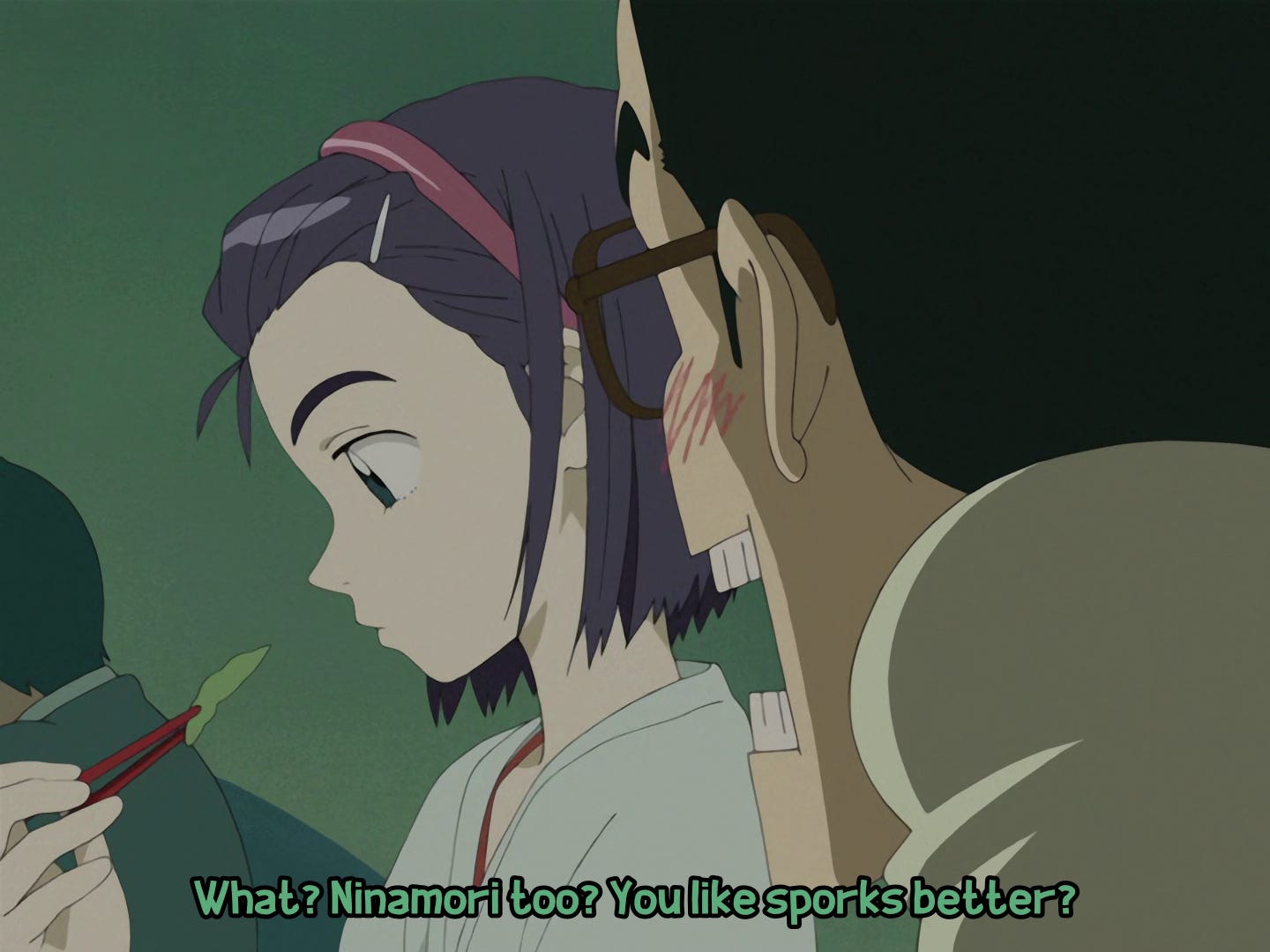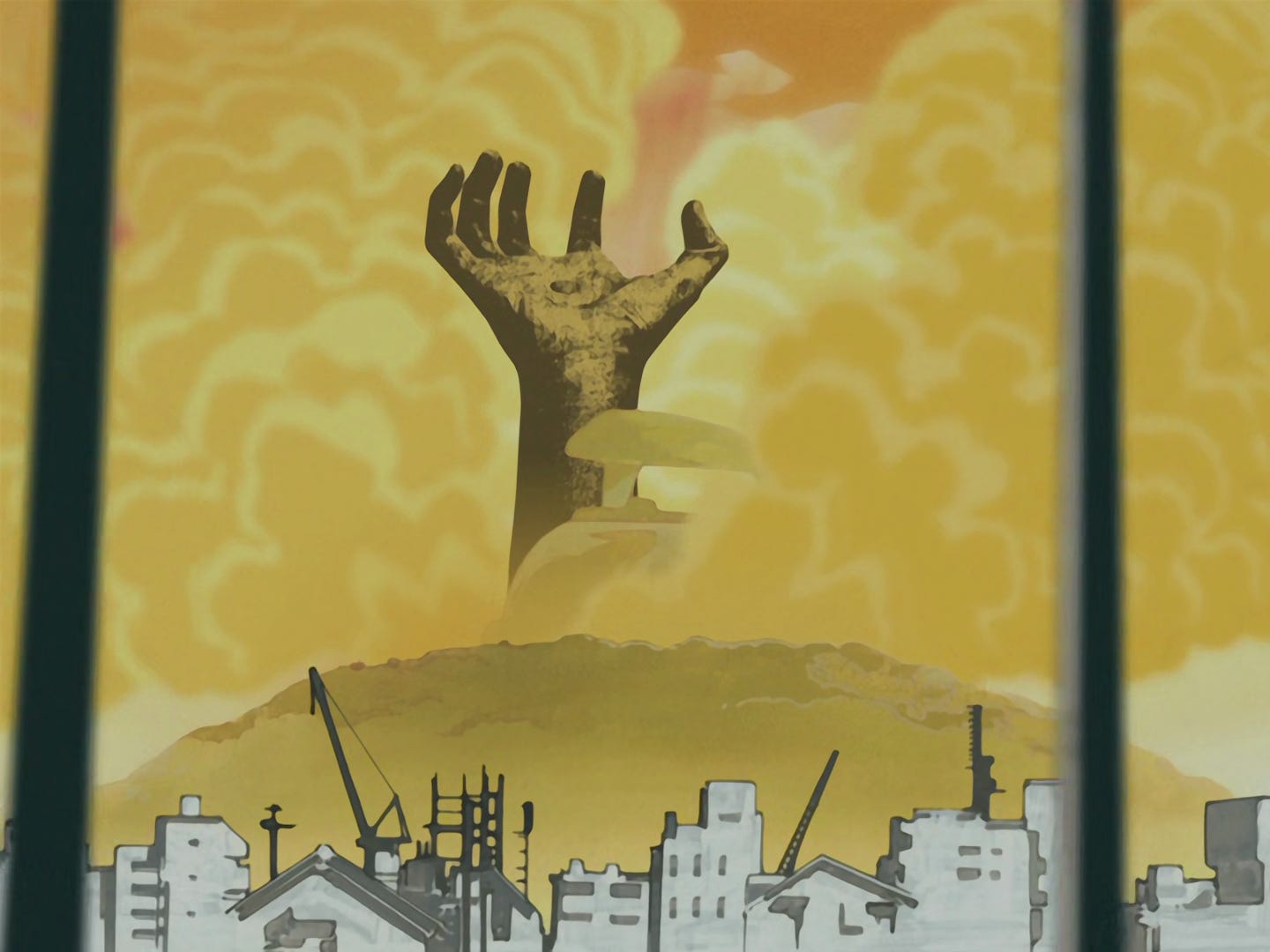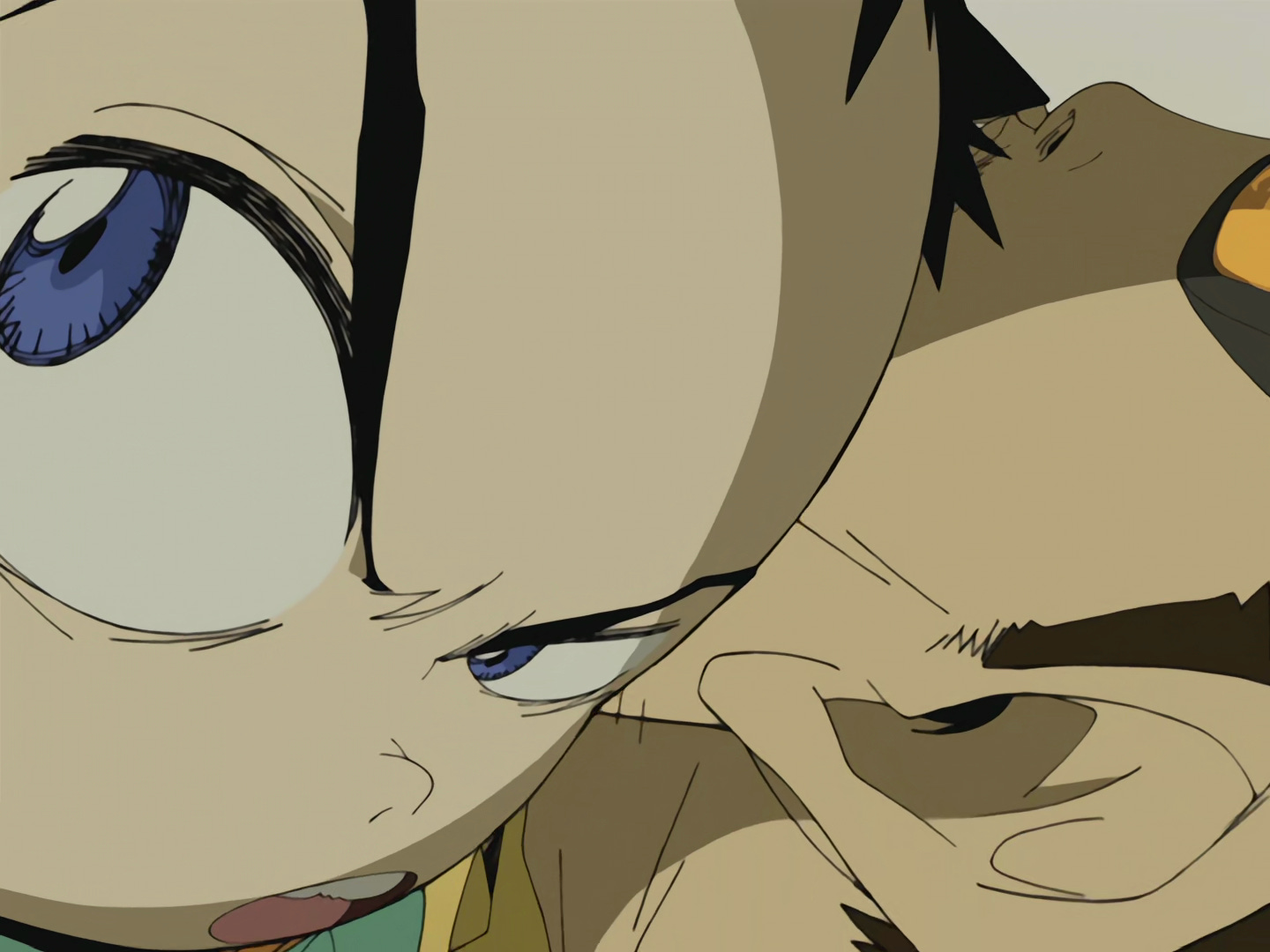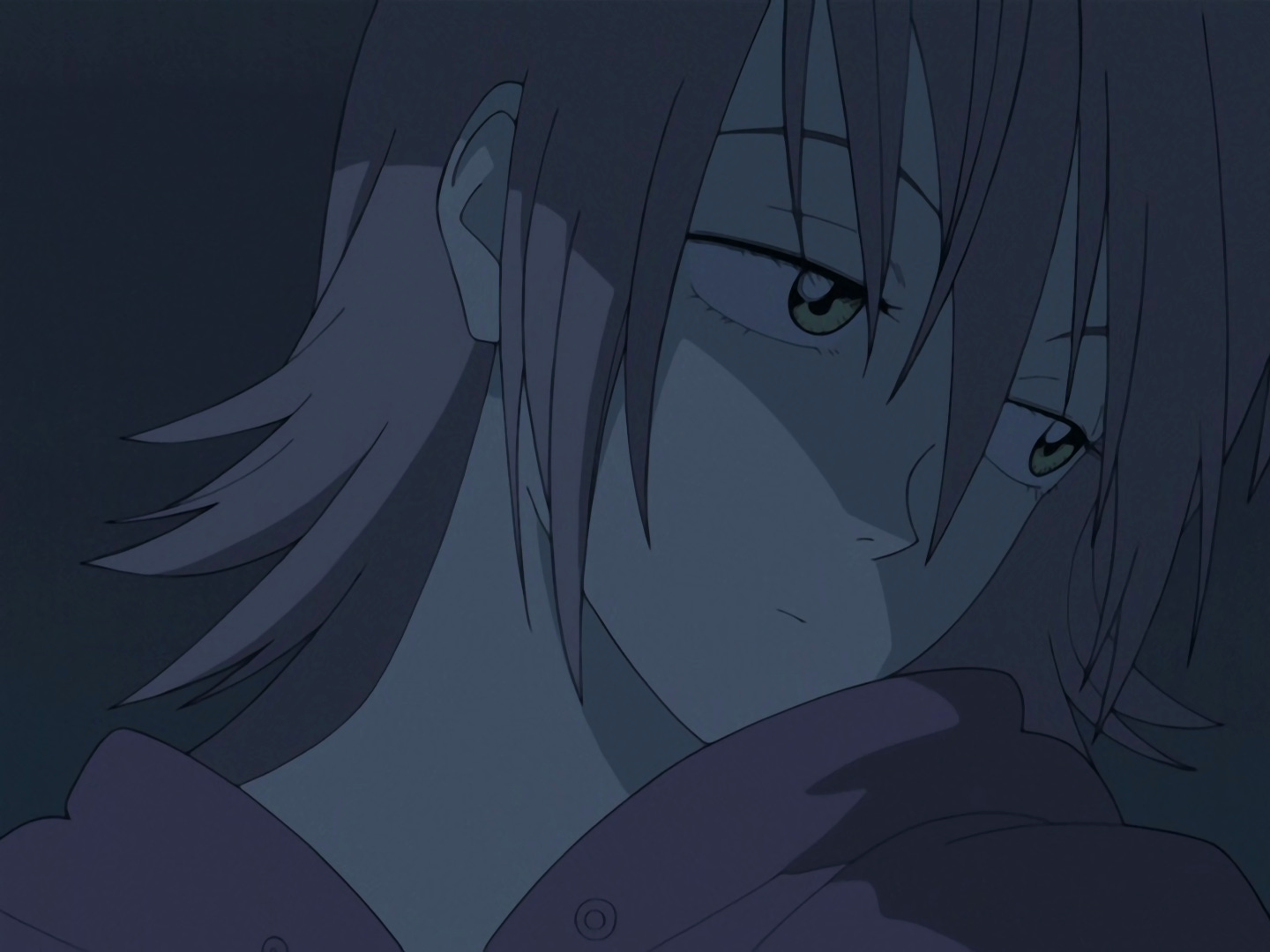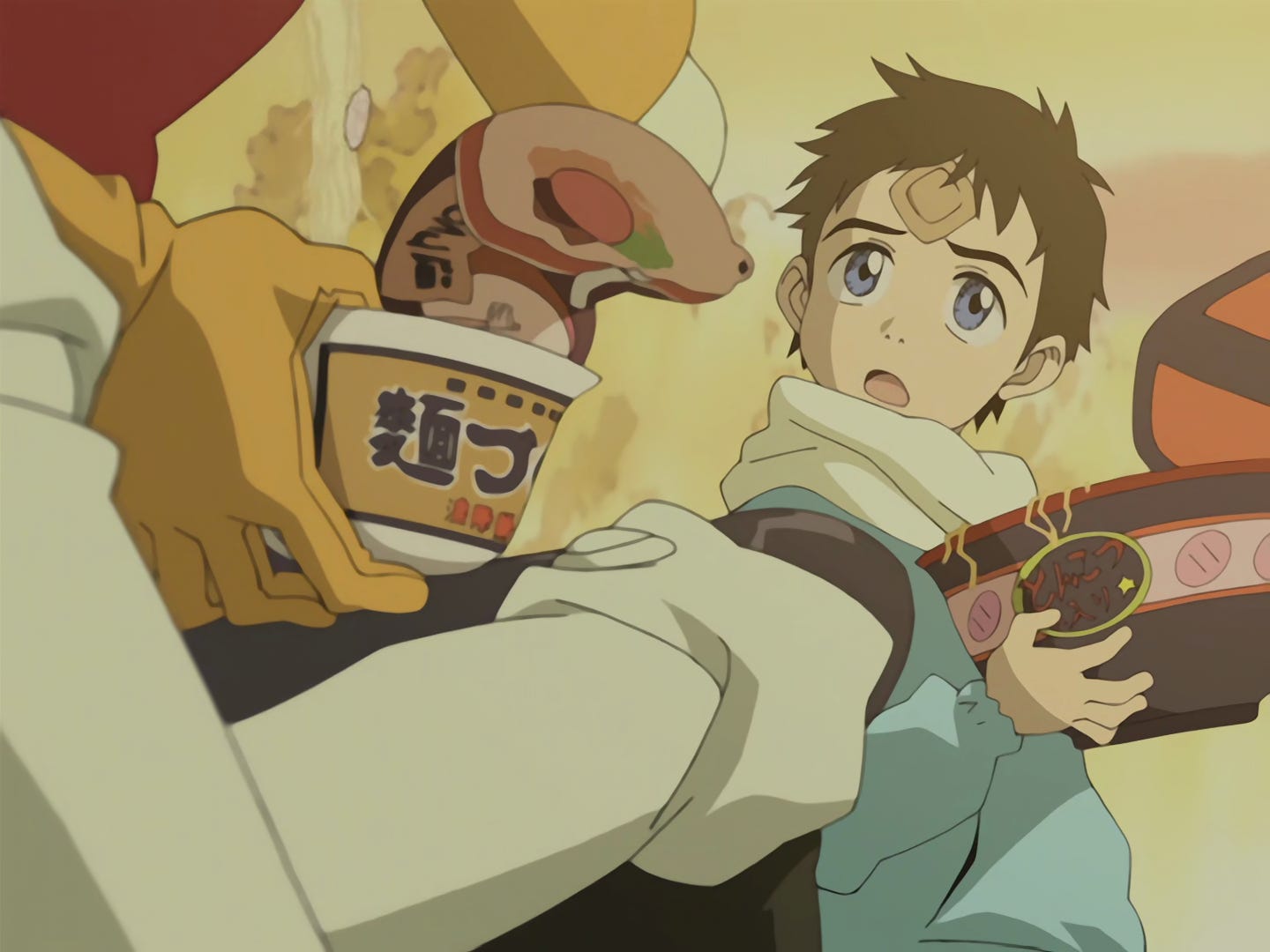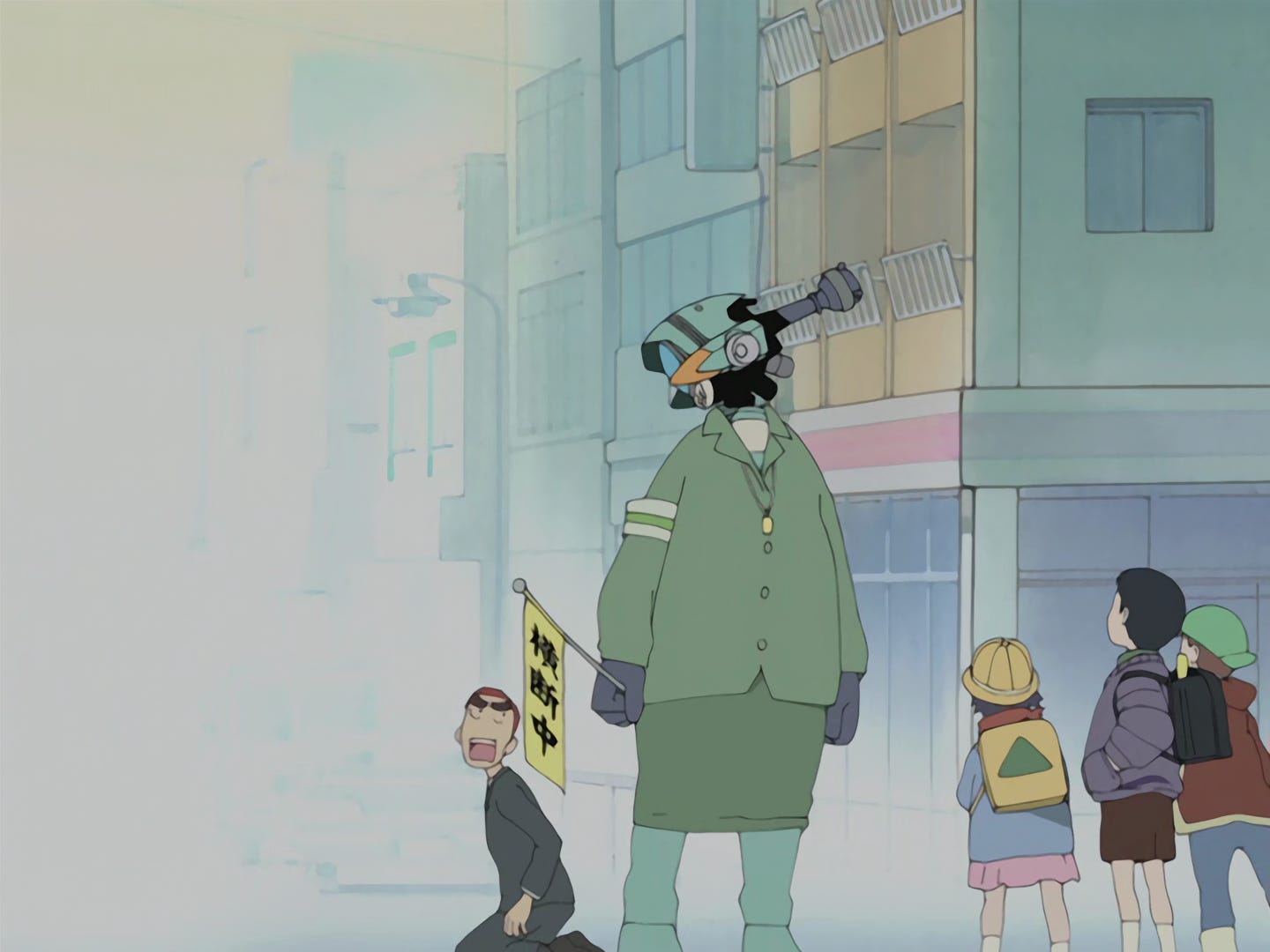FLCLick Noise - Episode 6
[Table of Contents Available Here]
STORY: The giant robot came to a halt, frozen in the shape of a hand. The city of Mabase appears at first glance to have returned to peace. Naota cuts class to run away from home with Haruko. Meanwhile Mamimi, upon encountering one of the broken fragments of the robot from the previous fight, names the machine "Takkun" and begins seeking revenge. However, she is unaware that Takkun was the terminal core that controlled the movement of the giant hand. When Takkun goes out of control and merges with that hand, the climax begins.
Interviewer: Well, now we have finally come to Episode 6, "FLCL." Our teacher Miya-jun looks like she is in a good mood, huh? (laughs)
Tsurumaki: [Tadashi] Hiramatsu worked very hard to expand on Miya-jun's character (laughs).
Sadamoto: (while listening to Gaku's "spork” comment) Is this really an erotic phrase?

Tsurumaki: Well, yes, I suppose so. This is where Enokido shines (laughs).
Sadamoto: A subtle eroticism (laughs).
Tsurumaki: When you only listen to the words, you might think they are saying something erotic, right? Like something about ‘the tip’ or somesuch (laughs).
Interviewer: Whose hand is this?
Tsurumaki: As for that...
Sadamoto: Didn’t you make this one yourself?
Tsurumaki: Well in Episode 5, it was [Kazuhiro] Takamura’s hand, but in Episode 6, it's mine. Initially, I asked Takamura since he had already appeared as a "photography actor for use in animation" (laughs). But for some reason, his work didn't turn out the way I wanted; I was like "it should be like this, with the base of the fingers bent outward!" (laughs intensely).

Sadamoto: So, he failed as a hand model.
Tsurumaki: I was the one saying things on set like, "You can do this!”, and he would reply "No, I can't." In the end, I had to do it myself.
Interviewer: (Amarao hands Kitsurubami a drink.) What are they drinking here?
Tsurumaki: It's just a sports drink.
Interviewer: Ah ah, is Kitsurubami freaking out about an indirect kiss?
Tsurumaki: Well, given that its Amarao, it might have been an extremely overly sweet sports drink.

Tsurumaki: This here is the Suzuki Ran scooter.
Sadamoto: But the sound is from a Vespa (laughs). We shouldn't have reused the same sound, right?
Tsurumaki: Oh dear (laughs). In my mind, the Ran scooter is what the delinquents ride, but when we were creating the show, that model wasn't being sold anymore. I don't remember who it was that told me, but I heard a story that one was parked near one of the production staff member’s house, so we took a photo of it and used it as reference material.
Sadamoto: It's name is written with kanji for "orchid" [蘭/Ran], right?
Tsurumaki: (Referring to the scene with Mamimi and the small robot under the bridge) This is also [Masahiko] Otsuka's work, isn't it? He's really good. The part where [the robot] Takkun appears is so cute.

Sadamoto: (Referring to Naota encountering Amarao on his way home from school) It's amazing how he is just standing on top of a sewer pipe (laughs).
Tsurumaki: Hiramatsu did the storyboards here.
Sadamoto: Why is Amarao up there? (laugh).
Tsurumaki: And the sewer pipe is pink too. The art department had a tendency to do things on their own. I mean, pink sewer pipes, what's up with that? (laughs)

Interviewer: Did you and Hiramatsu split the work of doing the storyboards?
Tsurumaki: Yes, initially I was supposed to do everything, but the script was delayed, so Hiramatsu helped me with the already-planned first half. The scene with the chopsticks at the beginning and the current scene were both done by Hiramatsu, as well as the part under the overpass with Mamimi and Takkun. In the end, Hiramatsu did about one-third of the storyboards.
Interviewer: Mamimi is quite a dark character, needless to say (laughs).
Tsurumaki: Well, she is indeed dark.
Sadamoto: Very dark.

Tsurumaki: There's a manga by Hideo Azuma1 called "A Machine From the Sea" where the desires of the protagonist, including desires she's not aware of, are seen in her mind by a machine and it starts taking actions to fulfill them. So, the protagonist girl is troubled by these actions, but it turns out those things were her true unconscious thoughts, something like that. I thought of having a similar feel. At first, Mamimi just wanted to get revenge on the people who bullied her, but her desires kept growing and ended up destroying the city.
Interviewer: This part here is identical to the scene in Episode 1...

Tsurumaki: It's Imaishi’s work. We left this part entirely in his hands. We didn't even draw storyboards, so it was completely up to him.
Interviewer: Ah, then they run out of breath right in the middle of the scene (laughs).
Tsurumaki: The directorial intent is something like "I got tired, so we couldn't finish the section in time" (laughs).
Interviewer: It's incredibly self-referential.
Sadamoto: This part (referring to the intense confrontation between Naota and Kamon) is amazing, isn't it?

Tsurumaki: It's great, right? I think the team probably used some slightly curved CG elements and animated on top of them.
Interviewer: Oh, may I ask something?
Tsurumaki: Sure.
Interviewer: I’m sorry if it seems like I'm changing the topic so suddenly (laughs). I didn't notice until this scene (Naota hugging Haruko in his room), but the Nandaba family is a so-called single-parent household, right? And Naota is projecting the image of his mother onto Haruko.
Tsurumaki: No no, that's not really correct. If we were trying to portray Naota projecting his mother onto Haruko, we would have emphasized the absence of his mother more.
Interviewer: Hm...
Tsurumaki: Conversely, it might have worked if we depicted a situation where Haruko enters a family where the mother is present too; but that would have been challenging to do. "Urusei Yatsura" is a bit peculiar in that aspect. In Urusei Yatsura, Ataru has both his mother and father, and then Lum comes into their lives, which works well in that show. But in other works, when a situation arises where a girl suddenly invades a boy's home and they start living under one roof, it's more likely that the boy would be living alone or the mother at least wouldn't be there. So, in "FLCL," I decided to exclude the mother from the beginning. I wanted to create a story that doesn’t touch on the mother at all.
Interviewer: I see, that's why I think this scene is significant. Until now, Haruko was seen as an object of Naota’s romantic attraction, but in episode 6, she suddenly becomes emotionally close to him. I think this is because Haruko previously left him, but also it feels like the show is portraying their relationship having taken a step forward from how it was before.
Tsurumaki: At the end of the episode, Naota says "I love you" to Haruko, so even at this point Naota does not think of Haruko as a substitute mother. Of course, there is a change in Naota's feelings compared to the previous episode. He is starting to be more honest; or rather, he is beginning to realize his true feelings, which he had not realized he was hiding from himself.
Sadamoto: On the other hand, how does Haruko feel about Naota? At the end she says, "You’re just a kid," but what about during this scene?
Tsurumaki: I think she is fond of him, at least. However, for her Naota is merely a tool, a means to obtain Atomsk.
Interviewer: And at the end of this scene, there's a shot of her with a sober expression.

Tsurumaki: So, even though she says kind things and seems to be trying to win Naota over, she remains detached. Naota doesn't look at her as he embraces her, but in that moment, Haruko is depicted as very removed. For her, obtaining Atomsk is more important than anything else. Sacrificing that desire for the sake of kindness, compassion, or even basic humanity is out of the question. It's also the case that unless she exploits Naota even more harshly, she won't be able to get Atomsk.
Interviewer: That's what we found out in episode 5, right?
Tsurumaki: I never explicitly decided what Haruko's true intentions were either. I only understand it at the level of Naota’s own understanding; it wasn’t clear even to myself. So, Haruko's portrayal is somewhat free-handed in that regard, and the parts where Naota doesn't understand her, I also had not firmly decided at the time. But I think that's okay, I drew those scenes with that in mind. However, that doesn't mean I think Haruko is plotting something sinister or anything. She probably doesn't intend to deceive anyone, nor does she have a need for it.
Sadamoto: Instant noodles!

Interviewer: Ahahaha (laughs).
Sadamoto: While eating homemade noodles, we are talking about bad ramen (laughs).
Tsurumaki: No no, the instant noodles are delicious!
Sadamoto: Is that so, huh? Apparently they are delicious (laughs).
Interviewer: Was there a promotional deal with “In Jelly” energy drinks [the brand on screen at the time]?
Tsurumaki: In the end there was no deal with In Jelly. We didn’t have promotional deals with Vespa, Rickenbacker, or anyone else whatsoever, actually.
Sadamoto: Right, we just had the idea to include various small, everyday items in the story.
Tsurumaki: And the camera, as well.
Sadamoto: Furthermore, it let us bring out our particular fascinations. We only drew things we liked (laughter). (Observing Mamimi and Takkun wandering around the town) Mamimi's getting darker and darker, is that intentional?

Tsurumaki: It's not that her heart is turning dark per se, but more that she's been building a "vengeance list" out of her unpleasant memories and trying to punish those responsible one by one... that aspect was there from the beginning.
Interviewer: (Scene of Mamimi next morning) Wow, her face looks even worse (laughter).
Tsurumaki: Hahaha, it's not that her face is intended to look ‘worse’, it's more like expressing that she's tired, but that does make her look like a delinquent (laughter). She was probably up all night seeking revenge.

Sadamoto: In this scene (Mamimi being found by Gaku and Takkun going berserk), Mamimi's change in expression is very well done.
Tsurumaki: For an instant, she makes a frustrated face, you know, like "damn it”.
Sadamoto: And after that “damn it” comes an “ah-ha” moment of revelation. Did Sushio draw this scene?

Tsurumaki: It might be... I'm not quite sure.
Sadamoto: Either Sushio or [Yusuke] Yoshigaki, right?
Interviewer: What's the license plate number of this car?
Tsurumaki: What is this one... I can't remember at all.
Interviewer: Ah, it's from Fukui [Prefecture]. “Fukui 291”
Sadamoto: For Fukui Yukari2, right?
Tsurumaki: Oh, it is! (laughs) I wonder if that was done by Hiramatsu. (While looking at the scene of Kamon) Thanks to Gendo Ikari from Evangelion, when it comes to glasses, it's firmly fixed in people's minds that they should be orange (laughs).
Interviewer: So, here they encounter the giant-ized Takkun.
Tsurumaki: We just explain everything with dialogue (laughter). And then, right when you are thinking, "Where is Canti?" he shows up in a place like this.

Sadamoto: He has become a school crossing guard
Tsurumaki: We really just explain everything that is going on in an instant.
Sadamoto: I really like the way [Mamimi] gets stuck and can't be shaken off here.
Tsurumaki: I like it, yeah; we put in that kind of scene quite often.
Sadamoto: We did it in the first episode of "Diebuster" and also in the first episode of FLCL.
Interviewer: Its nice to be dragged into something without your consent, isn’t it?
Tsurumaki: I suppose so. I don’t take action of my own free will, so it's nice to somehow get involved anyway (laughs)

Sadamoto: This part is cool. I like it.
Interviewer: And the terminal core is just the right fit for it.
Tsurumaki: We don’t explain this part either (laughs).。
Sadamoto: We really didn’t explain it, did we? “It's an alien, it doesn’t have to make sense”.
Tsurumaki: I like those kinds of aliens. If humans can understand them to some extent, they don't need to be aliens.
Interviewer: Is the design for Atomsk your work, Sadamoto?
Sadamoto: After his transformation, yes.
Tsurumaki: Rather than a transformation, it's the true form of Atomsk that appears here at the end which is your design, right?
Sadamoto: The Atomsk in the first half [of the episode], Amarao's image of him, isn't mine. But the bird-man-like one in the second half is mine.
Tsurumaki: That's strictly the Atomsk of Amarao's imagination. He only knows of Atomsk from documents and rumors.

Sadamoto: How cool! This is just going right with what feels good. The face is a bit like Naruto though (laughs).
Tsurumaki: Remind me who did this part?
Interviewer: Did Tsurumaki request Atomsk to have this bird-man design?
Sadamoto: It's meant to be this bird-man with unbelievable power, right?
Tsurumaki: Yes, that’s right. I wanted him to have the image of an alien with immense power. I didn't want him to be an ordinary human.
Sadamoto: It's boring if it's a human.

Tsurumaki: Haruko is always seeking Atomsk. But I always thought it shouldn't be just a simple romantic relationship. Of course, I did make it deceptively appear that way.
Sadamoto: However, when I first heard about the initial proposal, we were calling him Kanji - as in, a “Tokyo Love Story” kind of deal3. So we talked about how Atomsk was a man and that they used to be partners.
Tsurumaki: Yes, we started with that intention. In essence, Naota falls in love with Haruko, but Haruko has someone she's been in love with from the start. I thought about developing it in that direction, but as the story progressed, I started feeling that if we just made it a straightforward romantic relationship, Haruko's character would become too simplified and she wouldn’t be my vision anymore. I wanted to shift it a bit; Haruko desires Atomsk, and at the same time, she wants to possess Atomsk's power. So I was thinking, how can we design Atomsk so it doesn't appear too much like a typical romantic relationship?
Sadamoto: How would she acquire his power?
Tsurumaki: Haruko has a line, "I'm the one who will devour him." While "devour" can be a cliche euphemism for sex, here she means she really will eat Atomsk and take his power for herself. It's a bit like the cannibalism of primitive tribes, where they eat enemy warriors to take their power. I think as an alien Haruko would actually eat him.
Sadamoto: He’s so big though (laughs)
Tsurumaki: Well, I don’t know (laughs). You know, currently there is a manga by Hiroaki Samura4 called "Halcyon Lunch". I was thinking of something along those lines at the time. Additionally, in Chohei Kanbayashi's5 "The Enemy’s the Pirates", there's an alien cat called Apulo. And Apulo eats humans like he is sucking them dry.
Interviewer: So she would swallow him whole?
Tsurumaki: [In The Enemy’s the Pirates] In those scenes a life form is transformed something like ectoplasm and then eaten. Since "FLCL" is an anime that respects Chouhei Kambayashi, I thought that's what Haruko would do (laughs).
Sadamoto: Ah, I see.
Interviewer: To circle back a bit, Atomsk’s original concept was a bird, right?
Sadamoto: Yes, something not human seemed better.
Tsurumaki: I also wanted the image of something god-like. Like in the “Guin Saga”6 novels, that doesn't have to be human. I had something similar to the Egyptian gods in mind.
Sadamoto: Ah, like comic artist Enki Bilal7. I get that vibe too.
Interviewer: Something unreachable by any person’s grasp. In Amarao's mind, he’s a very muscular man, but in reality, he is more of a transcendent being.
Sadamoto: Haruko knew that, of course.
Tsurumaki: Yes. Haruko once caught him. But then he either escaped, or was taken by Medical Mechanica. The chain on Haruko's wrist and the one on Atomsk's nose were once connected. That's why Haruko's bracelet reacts to Atomsk’s presence.
A manga artist born in 1950 in Hokkaido. He made his debut in 1969 with his work "Manga-Ō." He is known for his surreal style and the incorporation of SF gadgets into his works. His serialized work "Futari to 5-nin" (1972) in "Weekly Shōnen Champion" became a hit and is sometimes seen as a surrealist manga. He is also considered the creator of the genre known as "absurdist manga." He went on a long hiatus, but gained notoriety again with “Disappearance Diary" (2005), which depicted his own disappearance and experiences with alcoholism.
TN: He also is widely regarded as the “Father of Lolicon” and is credited with inventing the genre, his biggest claim to fame. This is left out of his bio in this book - surely by mistake, of course!
A voice actress born in Kanagawa Prefecture. Initially active as a gravure idol, she was selected as a winner of the [Nippon TV Promotional Campaign] "Nittelegenic" program in 2000. Before that, she debuted as a voice actress in "His and Her Circumstances" in 1998. Following her role as Junko in "FLCL", she also played the lead role of Nono in "Diebuster/Aim for the Top 2!" and is a regular in director Tsurumaki's works.
TN: One of the main characters of the manga/TV drama “Tokyo Love Story” is also called Kanji/Canti.
A manga artist born in 1970 in Chiba Prefecture. He debuted in 1994 with "Blade of the Immortal" which won the Afternoon Four Seasons Award. The story, which is still popular and ongoing, portrays the journey of Rin, a girl whose parents were killed by a group of swordsmen, and her immortal bodyguard Manji. The "Halcyon Lunch" mentioned in this conversation is a work currently serialized in "Good! Afternoon" written by Samura.
A science fiction writer born in 1953 in Niigata Prefecture. Started his writing career in 1979 when "Dance with a Fox" won the Hayakawa SF Contest. He's known for his speculative and unique sense of storytelling which garnered significant attention. "The Enemy is the Pirate" mentioned in the conversation is one of the rare long series by Kanbayashi. It depicts the adventures of Raul Latel Satoru, a detective from the Pirate Division in charge of capturing space criminals, and his partner Apulo.
A fantasy novel series by Kaoru Kurimoto that began its publication in 1979. From the outset, it was envisioned to stretch across 100 volumes. However, the story didn't conclude by the 100th volume and currently stands at 130 main volumes and 2 spin-offs. The author, Kurimoto, passed away in 2009, leaving the series unfinished.
A french comic artist & director born in 1951, he's a representative of the bande dessinée [Franco-Belgian] comic school. Known for his fantastical content and detailed art style, his work was very popular. What's being referred to in the conversation is one of his masterpieces, the "Nikopol Trilogy".



